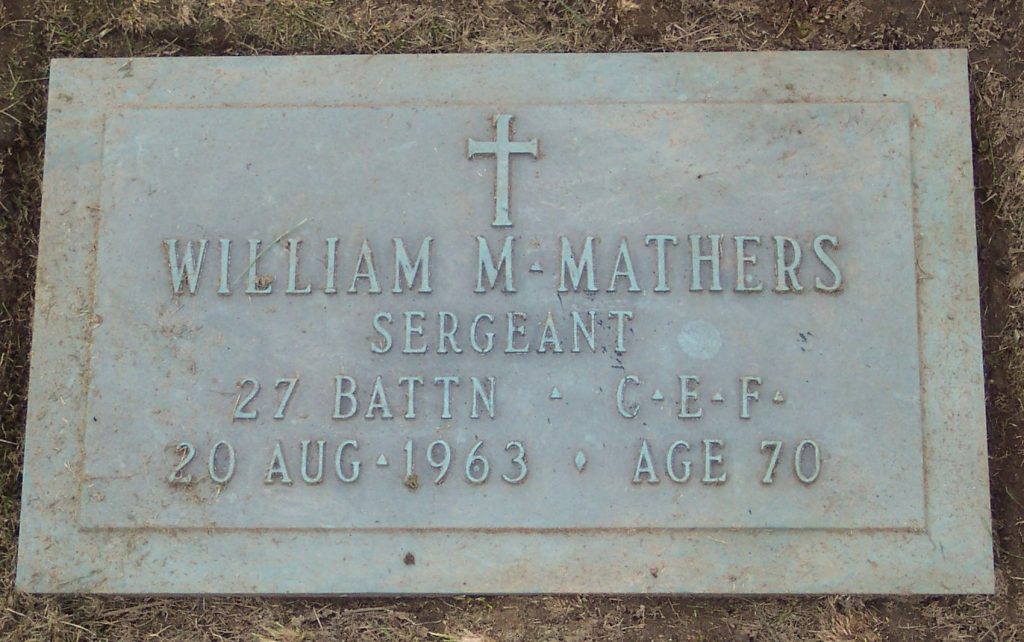Great War Dundee
This is Dundee's story of those that served in the First World War, and of the people left at home
We need you to tell us more about the life and times of William Matchett Mathers
William Matchett Mathers
Military Information
- Date of enlistment: 22.10.1914
- Place of enlistment: Kenora, Ontario
- Service no: 72091
- Rank: Sergeant
- Service Occupation:
- Awards:
- Regiment/Service: Canadian Infantry
- Unit/Ship: 27th Battalion
Personal Information
- Date of Birth: 08.03.1891
- Place of Birth: Dundee
- Address:
- Occupation: Dock Labourer
- Mother:
Mary Matchett
- Father:
Robert Mathers
- Siblings:
Jane, died 1904 aged 9
- Spouse:
Gertrude Alice Lightwood
- Children:
Robert
- Age at Death: 70
- Date of Death: 20.08.1963
- Place of Death: Shaughnessy Hospital, Vancouver, Canada
- Burial Country: Canada
- Cemetery: Forest Park Memorial Park, Burnaby, Vancouver
More about William Matchett Mathers
Sergeant William Matchett Mathers enlisted with the 27th Battalion in October 1914 and went overseas the following spring. He survived three years as a front line soldier in France and Belgium and returned to Canada with his battalion in May 1919. William was the oldest child and only son of Robert Mathers and Mary Matchett of Dundee, Scotland. His parents were married in April 1892 and he was born in Dundee in March 1893. He had a sister Jane who was about two years younger than him. His father worked as a van driver for a fruiterer and baker and he died of tuberculosis in 1899 when William was six years old. At the time of the 1901 census the two children were living in Dundee with their mother Mary and her widowed father, a foundry worker. A few months later, in August 1901, Mary also passed away, suffering from tuberculosis like her husband. William, age 8, and his sister Jane, age 6, were taken to the Dundee Orphan Institution by their grandfather and admitted there on 23 September. Sadly Jane also died of tuberculosis, passing away at age 9 in 1904. William spent seven years in the orphanage and when he was 15 he was sent to Canada, apparently to live with an uncle. William left Glasgow on the SS Grampian on 6 June 1908 and landed in Montreal nine days later, his destination listed as Kenora, Ontario. When the 1911 census was taken he was working in a sawmill and lodging with an elderly couple named John and Annie Kay. John and Annie were from Dundee, Scotland and they may have been William’s relatives. By 1913 both of them had died. The war started in August 1914 and two months later a 2nd Canadian contingent was being raised for service overseas. William was living in Keewatin at the time and training with the local militia, the 98th Regiment. He enlisted in Kenora on 22 October, joining the 27th (City of Winnipeg) Battalion. The battalion had just been organized and it was being recruited in Manitoba and northwestern Ontario. On 1 November William headed to Winnipeg along with fifteen other local volunteers and over the winter they trained in Manitoba. The following spring the recruits left for the east coast, on the first leg of the journey overseas. When their trains passed through Kenora on 13 May 1915 a huge crowd gathered at the station to see the local lads off and wish them well. The battalion embarked from Quebec on 17 May on the SS Carpathia and the men spent several months training at camps in England. On 17 September they marched to Folkestone on the coast where they boarded the Marguerite, disembarking at Boulogne, France the following day. Less than a week later the battalion was in Belgium. The War That fall the Canadians were holding a section of the front line south of Ypres. There were no major operations for them but the policy was one of aggressive activity against the Germans, including raids on their trenches. The battalions had regular rotations in the front lines and the men also spent time in working parties, digging and repairing trenches and dugouts, training and going on patrols. William was away for all of January 1916 due to illness, rejoining his unit in the first week of February. In early April the battalion took part in its first significant engagement, the disastrous and confused fighting at St. Eloi craters, where they suffered heavy casualties. William was wounded in the left arm and shoulder on 7 April and evacuated to England for treatment. He spent two months in hospitals and another month with reserve battalions. He was back in France with the 27th Battalion at the end of July. Over the next year his unit was in all the major Canadian battles: the Somme (Sept-Nov 1916), Vimy Ridge (April 1917) and Hill 70 (Aug 1917). William was promoted to Lance Corporal in February 1917 and he had ten days leave that fall, returning during the Battle of Passchendaele. The 27th Battalion captured the ruined village of Passchendaele on 6 November and the assault ended four days later. Afterwards the Canadians were moved back to France and during the winter and spring of 1917-18 they held a long stretch of the Allied line near Arras. In the summer of 1918 they were pulled from the line for eight weeks of intensive training in open warfare. In early August the 27th Battalion took part in the Battle of Amiens, which marked the beginning of the final period of the war, known now as the Hundred Days Offensive. The Canadian units were heavily involved in the operations in those last three months. At the end of August William was promoted to Lance Sergeant and on 4 October he suffered a minor wound during a German raid on his battalion’s position. In late October he was given 14 days leave in the UK and while he was away the Armistice was signed. The 27th Battalion took part in the March to the Rhine, crossing into Germany on 4 December and staying there as an occupying force until 24 January 1919. They spent the next few months in Belgium and in February William was promoted to Sergeant. Home The 27th Battalion returned to England on 13 April 1919 and on 13 May they embarked from Liverpool on the SS Northland, landing at Halifax ten days later. They arrived in Winnipeg by train on the afternoon of 26 May, a sweltering hot day, and a huge crowd had gathered to greet them. The returning soldiers paraded down Main Street and Portage Avenue to enormous cheering and applause, escorted by the depot battalion band. William was discharged from service that same day, with his intended address listed as Keewatin. In August he was honoured at a ceremony in Keewatin when medals were awarded to returned veterans and the families of fallen soldiers. By 1921 William had moved out west and he was married in Vancouver on 14 December 1922. He was working as a mechanic at the time and his wife was 17-year-old Gertrude Alice Lightwood. Gertrude was born in Liverpool, England and she’d come to Canada with her parents as a young girl. William and Gertrude had one child, their son Robert who was born in June 1924. Sadly Gertrude passed away in 1930 just four days after her 25th birthday. William never remarried and he continued to live in Vancouver, working on the docks and retiring in 1958. He passed away in Shaughnessy Veterans Hospital on 20 August 1963, at age 70, and he’s buried in Forest Lawn Memorial Park Cemetery in Burnaby. His son Robert died in Vancouver in 1984, at age 60. William is commemorated on the WW1 plaque for the Municipality of Keewatin and on the Dundee Orphan Institute War Memorial, 1914-1918.By Kenora Great War Project
Gary Thomson and Kenora Great War Project
Can you tell us more about William Matchett Mathers'? Some additional facts, a small story handed down through the family or perhaps a picture or an heirloom you can share online. Contact our curator...

